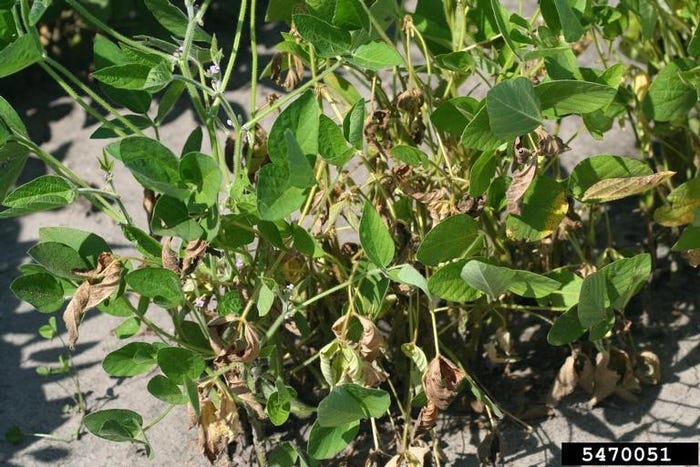July 13, 2018

Source: Penn State University
By Alyssa Collins and Paul D. Esker
It's no secret that soybean growth and development is all over the board, with some fields only recently planted, while others now at flowering (R1 to R2 growth stages). We can also appreciate that within some of these fields the soybean stand is variable, which maybe is not all that unsurprising given the spring conditions we observed with lots of rainfall (Figure 1).
With that background, this is a very good time to take an assessment of the stand quality, especially related to soybean stem diseases. As the season continues we need to pay attention to pockets or areas of the field where the stand does not appear to be improving. In Pennsylvania, we know that soybean can be negatively impacted by different stem diseases, for example, since 2013, individual losses due to sudden death syndrome, brown stem rot, and stem canker have ranged from 1% to 3%. First and foremost, a proper identification is required in order to determine the potential impact at harvest, as well as to make decisions long-term as related to variety selection and crop rotation.
Scouting for soybean stem diseases can be tricky. Proper identification begins with knowledge about your soybean variety and if there is any resistance to specific soybean stem diseases, for example, Rps genes for resistance to Phytophthora root and stem rot. Nonetheless, we can also use a symptom key to help with proper identification of the different stem diseases. We have created a symptom key guide that was adapted from the Crop Protection Network, “Scouting for Soybean Stem Diseases” (Fact sheet, CPN 1002B).
Diagnostic key to help with identification of important soybean stem diseases
Step 1. Determine if there are external symptoms on the stems.
If “No”, focus will shift to looking at the pith tissue (see Step 2).
If “Yes”, attention will focus on identifying the external symptoms on the stem (Step 3).
Step 2. Is the pith tissue white or brown?
If “White”, we will then focus on foliar disease symptoms (see Step 2B).
If “Brown”, we can identify the disease as brown stem rot:

M. Draper, Bugwood.org
Step 2B. On the leaf, is there yellowing (early symptom) and necrosis (advanced symptom) between leaf veins?
If “Yes”, we can identify the disease as sudden death syndrome:


Photo by A. Collins
If “No”, and foliar symptoms include chlorotic middle and lower leaves, and wilting and scorching of the upper leaves, we can identify the stem disease as Fusarium wilt:

D. Mueller, Bugwood.org
Step 3. Do you see specks/dots or blotches on the stem?
If “Specks/dots”, go to Step 3B.
If “Blotches”, go to Step 3C.
Step 3B. Are the specks/dots in rows, or are they random and on lower stem or upper tap root?
If “Rows”, we can identify the disease as pod and stem blight:

If “Random and localized to lower stem or upper tap root”, we can identify the disease as charcoal rot:

Photo by A. Collins
Step 3C. We now need to identify the type and location of the symptom to provide the best identification:
Dark brown to purple blotches that originate from the soil line = Phytophthora root and stem rot:

D. Mueller, Bugwood.org
Dark red-brown/sunken blotches, not at soil line but around a node and without girding the stem = stem canker:

D. Mueller, Bugwood.org
White, fluffy growth or bleached white stem = white mold:

Photo by A. Collins
Dark blotches that extend to petioles, leaves can have a Shepherd’s crook appearance = anthracnose:

Photo by A. Collins
Originally posted by Penn State Extension.
You May Also Like




